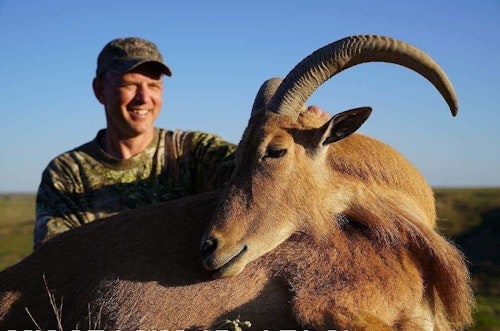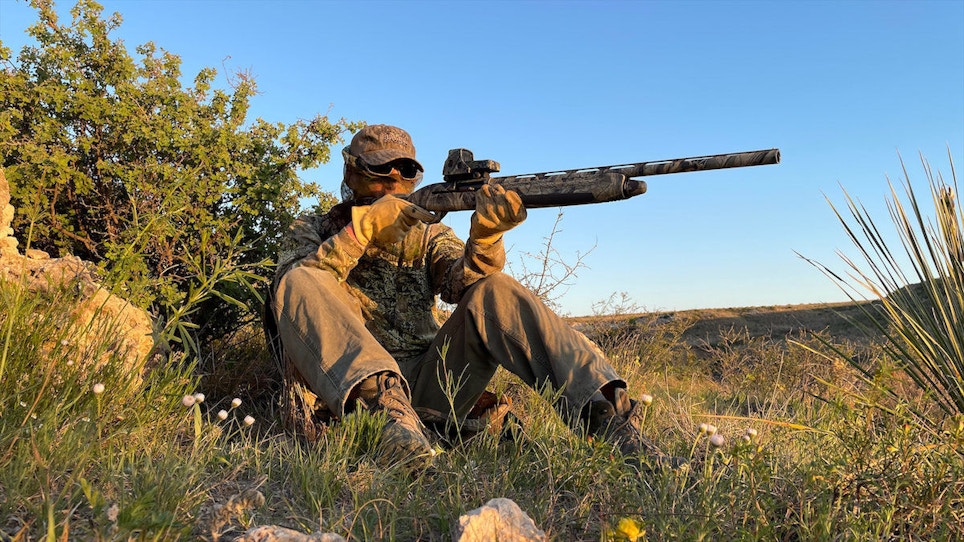The right sights make a difference. Anyone who’s spent enough time afield has learned that lesson.
During a three-day spring hunt in the Texas Panhandle with 4F Outfitters, I dropped two long-beards thanks to an EOTech holographic sight. I also settled the reticle of an EOTech SFP Vudu on the shoulder of my first aoudad.
Don’t confuse a holographic sight with a red-dot sight. There are two types of red-dot sights: tube red-dots and reflex sights. A red-dot uses a low-power LED emitter to project its reticle onto glass, which is then bounced back to the shooter’s eye because the glass is coated. Magnification is 1X, so objects are not enlarged.
Holographic sights such as the EOTech XPS that I used on my turkey hunt use a laser diode and mirrors to project a holographic reticle back to you without using the front glass; the reticle appears to float on your target in front of the sight housing itself. One significant difference to the shooter is with a red-dot you must choose whether to focus on the target or the red dot because they are on different planes. However, with a holographic sight, your eyes will focus on both the reticle and target simultaneously.
Other advantages of a holographic sight over a red-dot include:
· Minimal parallax distortion; no matter where the reticle appears in the sight housing, if you place the reticle on the target as you squeeze the trigger, you’ll hit the target.
· It continues to work if the front lens is partially obscured by mud or snow, or even broken.
· It works better with a magnifier. The precision center dot of a holographic reticle doesn’t increase in size with an increase in magnification.
· For stealth, holographic sights have a non-reflective sight window.
The specific EOTech holographic site I field tested in Texas was several years old and had been used and abused by guide Cade Ferguson for turkeys and predators. The current model that replaces it is the EOTech HWS XPS2 (HWS stands for holographic weapons sight); MSRP is $575. This sight measures 3.8 x 2.1 x 2.5 inches and weighs 9 ounces. It’s powered by a single CR123 lithium battery, which provides 1,000 hours of continuous use at a middle-of-the-road setting (12). The XPS2 offers 20 daylight brightness settings. It mounts to a 1-inch Weaver or MIL-STD-1913 rail, and features 0.5-MOA-per-click windage and elevation adjustments.
Right For Any Light
When hunting turkeys, it’s important to clearly see a scope’s reticle under a variety of lighting conditions. The same is true for coyotes, which we also pursued during my Texas adventure.
When the sun was still below the horizon, I dialed the EOTech holographic sight’s brightness to a dim setting so it wouldn’t overpower my view. Had a tom arrived during the first 30 minutes of legal shooting light, the red color of my reticle would’ve been no brighter than a gobbler’s red head; I could control my sight picture perfectly.
As the day brightened, I simply pressed the up arrow on the EOTech until the reticle hit the desired level. For example, when waiting on a coyote under a blue sky at high noon, I bumped up the reticle brightness to a much higher setting.
With a red-dot sight, it’s important to align your head directly behind the sight to ensure your point of impact doesn’t shift. This is the parallax distortion I mentioned previously. I didn’t have to worry about that with the holographic sight. My shotgun pellets would fill the ring of the sight’s reticle, regardless of whether I shouldered the shotgun perfectly.
Texas Two-Step
On the hunt, three gobblers finally circled our ambush position at 18 yards, walking single file at a steady clip from left to right, searching for the hen sounds Cade had been giving for the last 15 minutes. I slowly raised my loaner shotgun and the reticle came into view like I’d been using it for a lifetime. The three toms didn’t see me sliding the shotgun into firing position, so I had a moment to assess the situation.
I slowly shifted the gun to the middle bird, the largest.
I placed the center dot on the tom’s red head and tracked him, pulling the trigger without stopping my barrel swing. The gobbler hit the ground hard, and because I had two tags, I pumped the Remington 870 and found the lead bird, which was beginning to run back to the left. I focused on keeping the bird’s moving body within the reticle’s outer ring, but I failed to swing the barrel as I pulled the trigger, sending a swarm of pellets into the bird’s tail feathers. Cycling my third and final shell (Cade still had a plug in his shotgun from waterfowl season), I tracked the sprinting tom in the reticle’s outer ring and rolled him at 30 yards.
As I walked up to the birds, I remembered what Cade had told me the night I arrived in camp and was looking over his shotgun/sight combo. “On a running coyote, just swing the barrel and keep the coyote’s head or chest in the outer ring of the reticle as you pull the trigger. Dead coyote every time.” It works on a running turkey, too.
Coyote System
I’ve done a bit of coyote hunting in my career, but Cade is a seasoned veteran.
“We run a two-gun system,” he explained. “One guy carries a shotgun and sits low, about 25 yards behind the electronic call and decoy. Shooter two has a rifle and sits with me at a higher elevation; we’ll be 50 to 75 yards behind the first hunter.
“Believe it or not, we kill 80% of our coyotes with a shotgun. That’s the goal, to have a coyote charge in tight to the call and decoy. I’ll tell the rifle hunter to shoot only if the coyote hangs up and looks like it won’t come closer, or if it starts moving away.”
When we set up for coyotes, I hiked low to place the electronic caller and then sat down 25 yards from the call against some cover to break up my silhouette. Cade sat high with Jacob Fambrough, the director of digital marketing for EOTech. Unfortunately, due to hot midday temperatures and strong winds, there wasn’t much coyote action during the 15 stands we attempted. (The best times would’ve been during the cool mornings, but we were chasing turkeys instead.)
We had one close call, but the coyote lived to hunt another day.
During our coyote pursuits, I carried Cade’s shotgun with the EOTech holographic sight. Jacob carried an AR-15 with an EOTech 1-8x24 SFP Vudu scope. The company offers this scope in both a first focal plane and second focal plane option. Most hunters are familiar with second focal plane design; the reticle doesn’t change size as you change magnification. In contrast, the reticle on a first focal plane scope does change size as you change magnification. The FFP is sometimes preferred by shooters who use the reticle as a measuring tool to determine shot distance.
The scope features a daylight-visible illuminated quadplex BDC reticle that will run approximately 500 hours with the included CR2032 battery. Measuring 10.6 inches long, the scope weighs 21.3 ounces and has a 30mm one-piece tube.
The 1-8x24 SFP Vudu has ultra-clear HD glass and fully multi-coated lenses, protected in a tough single-piece T6 aircraft-aluminum tube. My favorite feature is the throw lever, which makes it a snap to make fast magnification adjustments. MSPR for this scope is $1,399.
As I looked through this Vudu scope on the range at camp, as well as in the field during one coyote stand when Jacob carried the shotgun, I couldn’t help but think about how well this model would work on two of my bolt-action whitetail rifles. Because I most often deer hunt in the forests of Minnesota and Wisconsin, the 8X setting would satisfy any medium-range rifle shots, and having the option of dialing power down to 1X or 2X would be welcomed when faced with a 20- to 50-yard shot from one of my bow stands — close opportunities.
Aoudad Adventure
In planning for this Texas Panhandle trip, I never imagined I’d be crawling across rim rock in pursuit of aoudad. The story goes that a rancher released 19 aoudad in the Panhandle, and through the decades the population has exploded. The Texas Parks & Wildlife Department doesn’t consider it a game animal in this region like they do in southwest Texas, so it’s up to the landowners to control the population.
After a couple stalks that ended with animals busting us before I could get into shooting position, and one close-range (100-yard) encounter with a too-young pair of ewes, we spotted a group of animals sheltered from the sun, across a canyon. I tried aiming from a sitting position but couldn’t get comfortable and had to readjust.
“239 yards,” Cade advised. “See the ewe on the far right? That’s the one we want.”
In the prone position, I was rock solid; my sight picture barely moved. “On her,” I said. “She’s slightly quartering away, feeding, correct?”
“Yep. Put it on her shoulder.”
We’d sighted in the Savage .308 bolt-action with its Vudu 3.5-18x50 SFP to be dead-on at 200 yards, so there was no reason to complicate matters for 239. I placed the scope’s center dot on her shoulder and pressed the trigger to the rear. Not a second after Cade said “shoulder,” the canyon echoed the rifle’s report and the ewe dropped in her tracks.
Still looking through the scope, I cycled a second cartridge and waited for her to stand. After 10 seconds Cade said, “She’s not getting up. Aoudad are tough, but you hammered her.”
For medium- to long-range shots, the Vudu 3.5-18x50 SFP is up to the task. This second focal plane scope has EOTech’s XC High-Density glass and a lightweight, aircraft-grade aluminum 34mm tube. The scope features covered tactical turrets, side-mounted parallax adjustment, illuminated reticle and removable throw lever for quick magnification adjustments. Measuring 14.8 inches in length, the scope weighs 31 ounces. MSRP is $1,599.
I had the magnification dialed to 15 or 16 when I took my shot, and even though the ewe was tucked in deep shadows, I had no trouble precisely placing the red center dot on its reddish-brown coat. While a scope this size would certainly be overkill for deep-woods whitetail hunting back home, in open country it was an ideal choice.
For more information about EOTECH sights and scopes, visit www.eotechinc.com.







